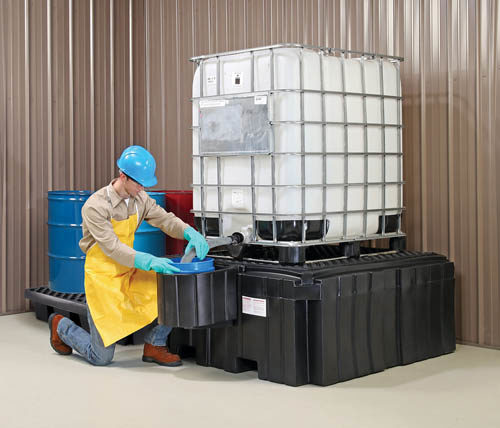Spill containment: active vs. passive
What’s the difference between active and passive secondary containment? Does my container require secondary containment?

Responding is Dan Ankney, technical support specialist, New Pig, Tipton, PA.
Spills can occur at any moment, so it’s critical to have containment measures in place – and you might actually be required to have them. Many regulations such as Spill Prevention Control and Countermeasure, the Resource Conservation and Recovery Act of 1976, and OSHA’s standard on hazardous waste operations and emergency response mandate that you have some form of secondary containment, so you need to know what that means.
There are two primary types of containment: active and passive. Active containment requires you to deploy a product, such as a spill kit or drain cover. These products are typically stored in a designated area where spills are likely to occur. It’s vital that employees know the location of these products and how to use them.
Passive containment is what most people think of when they hear the word “containment.” It consists of putting a preventive device in a liquid storage area to stop a spill from spreading. The most common types of passive containment are pallets, decks, trays and berms.
You must follow a few rules when using passive containment:
- Run-on, such as rainwater or snowmelt, can’t accumulate in the sump.
- The containment sump must be free of cracks, punctures and holes.
- Spilled liquid must be cleaned from the sump immediately.
- Incompatible liquids can’t be stored in the same containment area.
- If a spill occurs, the container can’t sit in the accumulated liquid.
Many factors need to be considered when selecting a containment device. First, you need to find out if local, state or federal regulations require a specific type or volume of containment. Second, environmental factors such as storage location (indoors or outdoors), nearby drains or navigable waters, and available space should be considered. The last factor to think about is chemical compatibility. Selecting a containment device that’s incompatible with the liquid you’re storing can cause a reaction. If the reaction is severe, the device could fail and you could contaminate the surrounding environment, harm wildlife or people, and face hefty regulatory fines.
Once a containment method is in place, it’s important to routinely inspect it to ensure it will be effective in the event of a spill. If a problem is found, it should be remedied immediately.
Spills can happen even in the most prepared facilities, so it’s imperative to have plans and products in place. Having the correct containment helps to keep the environment and employees safe.
Editor's note: This article represents the independent views of the author and should not be considered a National Safety Council endorsement.
Post a comment to this article
Safety+Health welcomes comments that promote respectful dialogue. Please stay on topic. Comments that contain personal attacks, profanity or abusive language – or those aggressively promoting products or services – will be removed. We reserve the right to determine which comments violate our comment policy. (Anonymous comments are welcome; merely skip the “name” field in the comment box. An email address is required but will not be included with your comment.)

